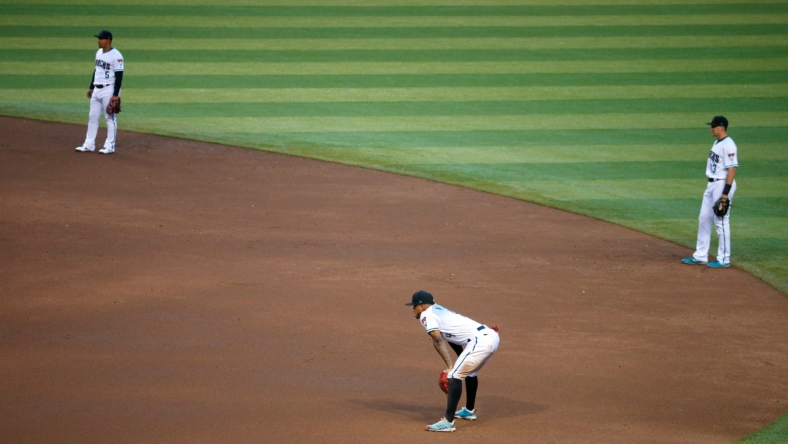For anyone who thought that spy balloon over Montana was a strange sight to behold, wait until you see what MLB Spring Training games might have to offer in a few weeks.
Bases that are three inches wider than before. Enforced pitch clocks. …
And nobody in left field?
Believe it or not, that could be a scene that plays out for at least some teams as analytics and field staffs across the game explore the best ways to adjust away from the new ban on extreme infield shifts, some executives predict.
The rule change requires all four infielders to be on the dirt — and two on each side of second base — before the ball is pitched.
Can’t put an infielder in shallow right field anymore for that extreme lefty pull hitter?
Nothing in the new rule says you can’t move the left fielder into that spot.
New Detroit Tigers president Scott Harris, who rose through the ranks in the Chicago Cubs’ and San Francisco Giants’ front offices, doesn’t see that becoming the next big thing in fielding innovation once the season starts, he said.
But until then?
New MLB rules
| Pitch count | Pitchers will have a 15-second pitch clock to start their “motion to pitch” by the expiration of the time. If the pitcher fails to do so, it is an automatic ball. If the hitter fails to be in position for his at-bat in that 15 seconds, it becomes an automatic strike. |
| Pickoff limit | Instead, they’ll be limited to two “disengagements” (pickoff attempts or stepoffs). If a pitcher disengages a third time for a pickoff attempt, the runner advances one base if the attempt fails. If there are runners on base, a pitcher will operate with a 20-second pitch clock. |
| Defensive shift restriction | There must be two fielders with their feet on the dirt on each side of the second base bag. Teams will no longer be allowed to position an infielder in the shallow outfield. It also means the four-man outfielder will no longer be permitted. The penalty is an automatic ball. |
| Bigger bases | They will now be 18 inches square, up from 15 inches square. The difference will reduce the distance between the bases by 4.5 inches, which means the famous 90 feet between bases is no more. |
“I imagine it’ll happen in spring training a lot as we adjust to the new environment,” Harris tells Sportsnaut.
And if it works for the right team with the right, range-gifted centerfielder — and the guts — to get aggressive?
“Everyone’s going to have those thoughts,” said Cubs president Jed Hoyer, who just signed a centerfielder, Cody Bellinger, who covered 30 percent more ground than average on fly balls during his 2019 Gold Glove year (per baseballsavant.com).
“We’ve talked about doing it before — do you go five infielders against a pitcher or something like that because of the ground-ball rate?” he said. “There’s real egg-on-your-face risk when you start playing two outfielders against a non-pitcher.”
Related: Sportsnaut’s updated MLB power rankings
What MLB teams would need for a successful outfield shift

Maybe a team like the St. Louis Cardinals, with athletic, strong fielding throughout its lineup, might be able to pull off a version of it. Maybe a team like the Chicago White Sox, with a porous fielding group overall but an athletic Gold Glove centerfielder in Luis Robert, might feel more urgency to think outside the box with the more traditional shift going away.
One thing every executive seems to agree on: The infield-shift ban puts a premium on athletic middle infielders with range again while exposing teams that don’t have them (often relying on shift analytics to cover for the deficit).
And this: Four of the top six — and three of the top four — biggest free agent contracts of the offseason went to the All-Star shortstops on the market. And there weren’t enough of them to go around for the teams that wanted them.
So tell us about that crazy outfield shift idea again?
“I do think there’s risk, but I bet you some teams will give it a shot against the right hitters,” Hoyer said.
Obviously, the Colorado Rockies can cross that option off the list at least during home games with the biggest outfield in baseball already a challenge to defend. And don’t expect the New York Yankees to consider it with a ballpark that gets really big, really fast once you get left of that short porch in right.
“I don’t see us doing that too comfortably,” said Yankees general manager Brian Cashman, who mused others might at least try.
“I’ve seen a lot of things that people have chosen to deploy that for good reason has worked,” he said.
If it actually works well enough for enough teams, it might not last long.
One executive from the commissioner’s office suggested that if such an outfield shift became successful enough and widespread enough, the rules could be changed again to counter the new trend.
For now, it’s just a theory running through the fertile minds and computer systems of geek departments across the game — with pitchers and catchers about to report next week to baseball’s annual, sunny laboratories of spring training.
“Certainly you’ve got a lot of creative minds in the game,” White Sox GM Hahn said, “and if there’s the opportunity to exploit an inefficiency it’ll be exploited.”
Gordon Wittenmyer covers Major League Baseball for Sportsnaut. You can follow him on Twitter at @GDubCub.
